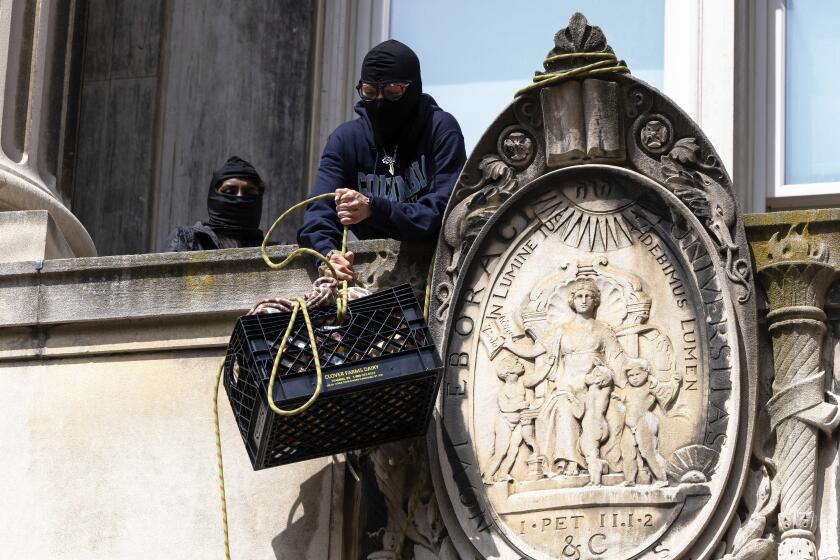Oldest Justice Still Staunchly Liberal : Brennan Now a Dissenter as High Court Edges Right
When Justice William J. Brennan Jr. was named to the Supreme Court in 1956, Dwight D. Eisenhower was President, “Peyton Place” was a best seller and the Dodgers were winning the National League pennant--in Brooklyn.
America has changed a lot since then, and so has the Supreme Court--but Brennan is still going strong, remaining true to his liberal beliefs. Although the court’s rightward shift has left him in a distinct minority, the oldest justice shows no intention of leaving the bench and allowing President Reagan to name his replacement.
“I can’t know, of course, what the Good Lord may have in mind for me,” he tells audiences these days. “But I can say that, insofar as the suggestions contemplate my voluntary departure, like Mark Twain’s reported death, the rumor is grossly exaggerated.”
Had he wished, the 79-year-old Brennan could have retired years ago in a blaze of judicial glory, the author of a long list of landmark decisions by the liberal Warren Court of the 1950s and 1960s. Even more than Chief Justice Earl Warren himself, Brennan has come to be regarded as the linchpin of that court’s liberal majority, and the milestone 1962 ruling that paved the way for the “one-man, one-vote” doctrine of legislative apportionment was just one product of his prolific pen.
But Brennan stayed on and now finds himself on the lonely liberal wing of a more conservative court under Chief Justice Warren E. Burger. Brennan still writes some major decisions--for example, last year’s ruling upholding Minnesota’s authority to require the Jaycees to open membership to women. Much more often, however, he is in the minority, writing bristling dissents against court decisions allowing capital punishment or easing the restrictions on police interrogations and searches.
Joined by Justice Thurgood Marshall, he still votes against the death penalty in every capital case that comes before the court, stating his view that capital punishment in all circumstances constitutes “cruel and unusual punishment” prohibited under the Eighth Amendment.
‘Pain and Suffering’
In April, Brennan urged the court to consider whether electrocution was an impermissible method of capital punishment because of the “unnecessary pain and suffering” it imposed. In a lengthy dissent, he cited vivid accounts of electrocutions--”the prisoner’s eyeballs sometimes pop out and rest on his cheeks”--and pointed out that jolts of electricity must often be repeated over a period of minutes before the condemned prisoner dies.
Dissent in Mitchell Case
Recently, he issued a sharp dissent to the court’s decision granting former Atty. Gen. John N. Mitchell protection against a civil damage suit that arose from his having authorized in 1970 a warrantless “domestic security” wiretap that later was ruled illegal. Brennan remarked tartly that he was “at a loss” to understand the court’s action, “aside from sympathy for the defendant or hostility to the plaintiff.”
The justice has taken his criticism of the court majority to public forums around the country. He recently told a legal audience in Macon, Ga., that court rulings favoring government authority over individual rights “condoned both isolated and systematic violations of civil liberties.”
And he voiced concern before an audience in New York about the court’s “disturbing” trend toward ruling against constitutional claims brought by individuals. The court, he noted, upheld constitutional claims in 86% of the cases presented to it in 1963 but in only 19% of such cases in 1983.
Brennan, one of only two Supreme Court justices with state court experience, has been encouraging lawyers to bring constitutional rights cases in state courts, which, more frequently, are extending broader individual rights under their own constitutions than are required by the Supreme Court. His views are regarded as widely influential on the more liberal and innovative of these state courts.
“Justice Brennan keeps the vision alive,” University of Chicago law professor Dennis J. Hutchinson said. “His views provide the moral support, encouragement and doctrinal respectability for the liberal vision of the law that he has.”
‘One of Great Justices’
In his 29 years, Brennan has won wide admiration from civil liberties groups. At a recent dinner of the Constitutional Rights Foundation in Los Angeles, he was introduced by the group’s president, Raymond C. Fisher, as “one of the great justices.” Fisher noted a study by former Harvard Law School dean and Solicitor General Erwin N. Griswold showing that Brennan had written 29 of the court’s major opinions from 1956 to 1978--compared to 14 by Burger and 13 by Warren.
But Brennan has critics also, persons who see him as a judicial activist trying to change society by manipulating the law to suit his liberal views.
The conservative National Review concluded in a lengthy article last year that Brennan, perhaps more than anyone else, was responsible for turning the federal judiciary into a “super-legislature” in which judges’ policy views prevail over those of the legislative and executive branches.
And James McClellan, executive director of the Center for Judicial Studies in Washington, said of Brennan: “He simply decides what policy he wants to implement and then finds the legal precedents to support it. He’s not regarded as a constitutional scholar of the first order but rather has been influential mainly because he’s been in power at a time when he could write opinions for the majority.
“He may be a mild-mannered man,” McClellan said, “but he is a very strong-willed political activist.”
Brennan’s record on the Warren Court alone will ensure his place in history. He was a close colleague of the late chief justice, a hard-working innovator who could bring together diverse views among the justices to produce important decisions.
“One might say that Justice Brennan’s opinions most embody what the Warren Court stood for and most clearly and fully represent the liberal tradition of that court,” University of California law professor Stephen R. Barnett said. “He clearly has been the leading spokesman for a point of view that was created with the Warren Court and that remains vital even up until today.”
During the Warren Court’s glory days, Brennan wrote milestone decisions that:
--Gave federal courts unprecedented power to review legislative apportionment plans, leading to the “one-man, one-vote” rule for representation within voting districts. Before that case, called Baker vs. Carr, the court had studiously avoided the issue as part of its desire to avoid the “political thicket.”
--Granted the press broad new constitutional protection against libel suits by requiring that public officials carry the heavy burden of proving “actual malice”--that the article was published with knowledge that it was false or with reckless disregard for the truth.
School Bias Ruling
--Mandated that school districts that had been guilty of racial discrimination may not get by with racially neutral “freedom of choice” desegregation plans but must take affirmative steps to attain racial balance.
--Barred states from forcing welfare applicants to establish a one-year residency before receiving aid and said welfare recipients are entitled to a hearing before their aid may be cut off.
--Gave criminal suspects the right to have a lawyer present at police identification lineups.
Even as the court grew more conservative as the Warren era ended in 1969, Brennan held his own. For example, he wrote opinions that struck down the denial of free public education to illegal alien children in Texas, upheld a voluntary affirmative action plan by a private employer that gave minority-member workers preference over whites in an apprenticeship program and opened the way for civil rights damage suits against cities when their official policies were found to violate an individual’s constitutional rights.
Now, however, Brennan is clearly out of the court’s mainstream. But, although he voted in the minority in 63 cases last term, more than any other justice, knowledgeable observers say that he still skillfully asserts his views to help narrow the scope of a majority opinion.
“He is still a force to be reckoned with,” Chicago’s Hutchinson said. “He knows cases so well, jurisprudence so well, that he is able to put together precedent and doctrine in such an innovative way that it forces others to stop and think.”
Manners of ‘Old Pol’
Brennan influences his colleagues not only with his legal ability but also with his powers of persuasion. He is a warm and friendly man in private and has long impressed court observers as having almost the manner of an “old pol.” Court aides say he frequently walks down court hallways with his arm tightly on the shoulder of a fellow justice with whom he is deeply engrossed in conversation.
Brennan was born in Newark, N. J., to an Irish immigrant who worked as a coal heaver in a brewery. He earned money as a boy by delivering milk and working in a gasoline station. Eventually, he received degrees from the Wharton School of Finance at the University of Pennsylvania and then Harvard Law School before joining a law firm in Newark, where he specialized in labor law. Later, he was a trial judge, appeals court judge and member of the New Jersey Supreme Court.
Appointed in 1956
Eisenhower named Brennan, a politically inactive Democrat, to the high court in 1956 and was considerably surprised to realize later that he had appointed a liberal. When asked if he had ever made a mistake as President, Eisenhower responded, “Yes, two; and they are both sitting on the Supreme Court”--a sardonic reference to Brennan and Warren, whom Eisenhower appointed in 1953.
Brennan was treated seven years ago for a cancerous tumor in his throat and, after a brief absence from the bench, seemed troubled by hoarseness. Later, as his wife, Marjorie, became increasingly ill from cancer before her death in 1982, Brennan publicly acknowledged that he was considering retirement.
But now, apparently fully recovered and remarried since 1983 to his former secretary, Brennan perseveres as the oldest member of a court that includes five justices 76 and older and only one (Sandra Day O’Connor) under 60. In the nation’s 196-year history, only 10 justices have served longer than Brennan.
More to Read
Get the L.A. Times Politics newsletter
Deeply reported insights into legislation, politics and policy from Sacramento, Washington and beyond. In your inbox three times per week.
You may occasionally receive promotional content from the Los Angeles Times.






